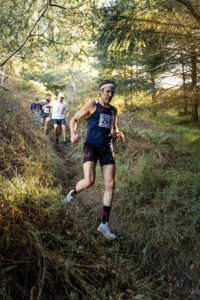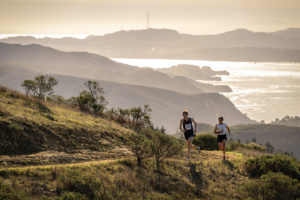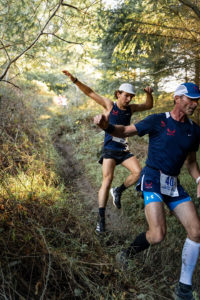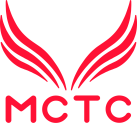Members of the Marin County Track Club showed out in full force at the 110th running of the Historic Dipsea Race. As the oldest trail race in America, the event draws premier talent from across Northern California and beyond. Due to COVID-19 precautions, this year’s edition was held in November instead of June. This change brought cool temperatures and faster times for many athletes.
MCTC was able to place two runners into the top 15 finishers, and 5 into the top 70 – no small feat considering the race’s unique handicapping system that forces faster athletes to pass slower ones on narrow singletrack trails. Leading the charge for MCTC was Eddie Owens, a newly-minted member of the U.S. Mountain Running Team who finished 4th and posted the fastest time of the day in 47:48. Owens’ time was among the fastest ever run for the course (even including times from the race’s earlier history, when the distance was shorter due to now-prohibited shortcuts). Also placing in the top 15 and earning a coveted black jersey was Patrick Wachter, who finished the race in a time of 51:59 for 15th place. Rounding out the top 5 for MCTC were Lyle Rumon (41st, 56:07), Antony Scott (53rd, 1:02:01), and Tom Rosencrantz (67th, 1:06:19).

The course follows the route of the historic Dipsea Trail, starting in downtown Mill Valley, CA, and finishing at nearby Stinson Beach, though at certain moments runners are able to make a decision to stick on the longer “consensus” trail or take a number of shorter, more treacherous shortcuts. Over about 7 miles and 2000ft of lung-busting elevation gain and loss, participants take in scenic views and historic locales offered by few other races.
Runners embark from the Depot and head for the Dipsea Steps, a set of 3 staircases that snake their way through the hillside neighborhoods of Mill Valley. After climbing the 671 grueling steps out of town, runners cross over the Panoramic Highway at Windy Gap and drop down into Muir Woods National Monument.
“The top of the steps can be a make-or-break moment for some people who go out a little too hard,” said Wachter. “Luckily, I was able to have a good stretch from the steps to Windy Gap and continue my momentum up and over the highway.”
On the way down into Muir Woods, runners may elect to take the first major shortcut, a steep skid dubbed “Suicide.” Shortly after, runners make their way through the Muir Woods parking lot and cross Redwood Creek – a section of the course that was almost deemed off-limits by the National Park Service due to rainfall just days before the race.
For the toughest section of the day, there was a clear consensus pick amongst MCTC athletes: Dynamite. Immediately following the creek crossing, this technical section is known for causing congestion as runners fight for footing and positioning.
“It was crowded, steep, muddy and my legs were already trashed from going out hard and screaming down the first downhill,” said Owens. “So it was a tough transition back to the uphill.”
The climbing continues after Dynamite, though leveling out slightly on a section known to locals as Hogsback. This exposed section of trail criss-crosses with Deer Park Fire Road, giving runners ample opportunity to make passes on slower athletes.
When asked about this section of the course, Owens answered, “I was surprised Hogsback was as muddy as it was in certain parts because the rest of the course drained pretty well… I feel like it slowed all of us down marginally, but equally.”

Runners soon reach the highest point of the race, a hill aptly named “Cardiac.” Cardiac is often seen as the psychological midpoint of the race. The crowd presence there is intense, with spectators offering water, encouragement, and high fives as runners crest the steep climb. “It felt like I entered this tunnel of noise as I came out of the woods,” said Wachter. “There’s a passion people bring to the cheering section at Cardiac that, I think, rivals some of the larger road races in the country.”
From Cardiac, runners descend along the side of Mt. Tam, picking up speed towards the second of the most well-known shortcuts, “The Swoop.” Though sometimes this shortcut allows for quick passing opportunities, traffic can become an issue on the narrow trail.
“Swoop would have been faster if not for running into a train of people there,” said Rosencrantz.
After the Swoop, runners encounter a set of treacherous downhill steps before making their way up the final climb on the course, fittingly named “Insult.” Though a short climb, Insult is crucial; if runners overreach early, they may find themselves hiking as their competitors run by them. In this year’s edition, many runners were caught blindsided at the top of Insult: without notice, officials had blocked off the last major shortcut, a right turn onto the Panoramic Highway. Runners were forced to take the longer consensus trail up and over a section known as the Moors.

The last mile of the race allows runners to scream downhill into Stinson Beach, where they’re greeted by cheering fans, friendly volunteers, and, if they choose, a dip in the Pacific. Reflecting on the race, Coach Antony Scott expressed optimism for MCTC’s performance in future editions.
“Overall, the race was a great experience and I’m super motivated to go back and improve next year! Let’s get five MCTC Black Shirts!”
Next year’s edition is currently scheduled to return to the usual June date, meaning that fans won’t have to wait long to see MCTC athletes back in action on the trails of Mt. Tamalpais.
By Patrick Wachter
All 📸 @tonywithasony






